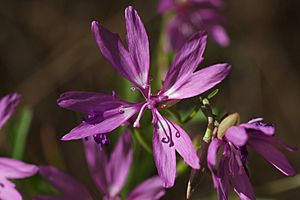Twolobe clarkia facts for kids
Quick facts for kids Twolobe clarkia |
|
|---|---|
 |
|
| Scientific classification | |
| Genus: |
Clarkia
|
| Species: |
biloba
|
Clarkia biloba is a beautiful flowering plant. It is often called the twolobe clarkia or two lobed clarkia. This plant belongs to the evening primrose family.
You can only find Clarkia biloba in California. It grows in the Sierra Nevada foothills. One type of this plant can also be found near the San Francisco Bay Area. It likes to grow in places like chaparral (a type of shrubland), oak woodlands, and yellow pine forests.
What Does It Look Like?
Clarkia biloba is an annual herb. This means it grows from a seed, flowers, produces seeds, and then dies all in one year. Its stem stands straight up and can grow almost 3 feet (1 meter) tall.
The leaves are long and thin, or shaped like a spear. They can be up to 6 centimeters long. Each leaf grows on a short stem called a petiole.
Flowers
At the top of the stem, you'll find the flowers. The flower buds hang down before they open. The sepals, which are like small leaves that protect the bud, are pink or red-purple. They stay joined together even when the petals open.
The petals are the colorful parts of the flower. They can be up to 2.5 centimeters long. Their colors range from pink to lavender to a bright purplish-red. Sometimes, they have small red spots. A cool thing about these petals is that each one has a tip that splits into two lobes, which is why it's called "twolobe clarkia"!
The flower has 8 stamens, which are the parts that make pollen. Some stamens have large, lavender-colored tops called anthers. Others have smaller, lighter-colored anthers. The stigma, which is the part that receives pollen, sticks out further than the stamens.
Different Types of Twolobe Clarkia
There are three main types, or subspecies, of this wildflower. They are all a little bit different.
- Clarkia biloba ssp. australis — This type is called Mariposa clarkia. It is the rarest one. You can only find it in the Merced River area in the Sierra foothills. It needs protection because of things like road work and new plants growing where they shouldn't.
- Clarkia biloba ssp. biloba — This is the most common type, also known as two lobed clarkia.
- Clarkia biloba ssp. brandegeeae — This type is called Brandegee's clarkia.
See also
 In Spanish: Clarkia biloba para niños
In Spanish: Clarkia biloba para niños

